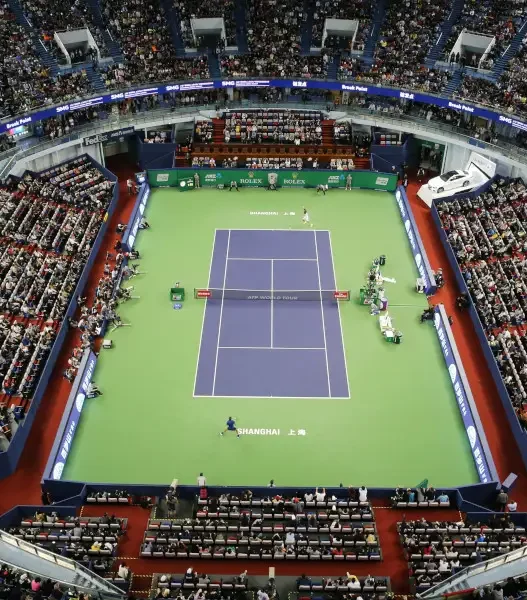So, you’ve decided to pick up a racket and venture into the fascinating world of tennis. Tennis, a game both physically challenging and mentally stimulating, is an excellent choice for maintaining fitness while having fun. However, as a newbie, the sport can feel a little overwhelming with its various rules, tactics, and techniques. But don’t fret. We’re here to help you navigate through the early stages of your tennis journey. Below, we’ve compiled 20 tennis tips for beginners – a comprehensive guide to ease you into your newfound hobby. Right from choosing the right gear to understanding tactical play and the importance of rest, we’ve got you covered.
“Tennis is a perfect combination of violent action taking place in an atmosphere of total tranquillity.” – Billie Jean King
Whether you aspire to become the next Serena Williams or Novak Djokovic, or you simply aim to impress friends at the local courts – embrace the challenge. Remember, every tennis pro started just like you, as beginners. It’s your turn now!
1. Get the Right Gear

First things first, let’s talk about the fundamental necessity for every budding tennis player – the racket. An incorrectly selected racket could derail your progress right from the start. Hence, it’s crucial to invest in a quality one that’s right for beginners. It should be light enough to manoeuvre easily but sturdy enough to handle powerful shots. Choosing a beginner-friendly racket can significantly impact your learning curve, making your initial encounters with the game much more rewarding.
Now, let’s not underplay the importance of your footwear and attire. There’s more to tennis attire than just style. Comfort is paramount since tennis calls for speedy movements and intense footwork. Shoes specifically designed for tennis can offer the right balance of grip and flexibility, keeping your feet comfortable, and reducing the risk of injury. Likewise, opt for breathable, flexible tennis attire to allow seamless and unrestricted movements. Remember – the more comfortable you are, the better you will perform on the court.
2. Learn the Basic Strokes
Mastering the Basic Strokes
First and foremost, learning to play tennis involves gaining proficiency in the key strokes: the forehand, the backhand, the serve, and the volley. These are the bread and butter of any successful tennis player, and need to be your priority from day one. Don’t rush to acquire advanced skills before getting these fundamentals right.
The Forehand
Your forehand is your main weapon during a tennis rally. Played with your dominant hand, a forehand groundstroke starts on your dominant side and finishes on the opposite side after contacting the ball. The power of your forehand comes from your core and your footwork, so be sure to put your whole body into this shot.
The Backhand
The backhand groundstroke can be harder to master, but it’s crucial for maintaining a balanced game. Usually played from the back of the court during a baseline rally, backhand groundstrokes can either be one-handed or two-handed, depending on your preference. Don’t worry if it feels awkward at first, with practice, it will become second nature.
The Serve
Each point in a tennis match begins with a serve, making it an essential stroke to perfect. Foot stance, grip, body positioning, and contact with the ball all play a role in a successful serve. While serving can be one of the most technically complex strokes in tennis, step-by-step practice will help you get the hang of it.
The Volley
Played close to the net, the volley requires swift reactions and accurate placement. It can be a game-changer when executed correctly, ending rallies quickly and giving your opponent less time to react. Practice both your forehand and backhand volleys, as you’ll need to be adept at both to compete effectively at the net.
Remember, every tennis player experiences the journey differently. Some skills may come more naturally than others. Stick with your training, persevere through the more challenging aspects, and most importantly, enjoy the learning process. Tennis is a sport that offers continued growth, with each practice and match bringing fresh insights and accomplishments.
3. Grip Techniques

Now that you’re set with the right gear and the basic techniques, it’s time to dive a bit deeper into the grips. As the grip is your main connection to the racket, it’s critically important in determining the kind of shot you’re able to hit. Different grips provide different levels of control, spin, and power. Let’s break down the three major ones – Eastern, Western, and Continental:
Eastern Grip:
If you’re just starting out, the Eastern grip might feel the most natural. It gives you a balance of controls and power in your shots without requiring extreme wrist flexibility. It’s best employed when you’re going for forehand groundstrokes and suites flat hitters with an aggressive baseline game. However, it might limit your ability with heavy topspin strokes.
Western Grip:
Though it might take a bit getting used to initially, the Western grip allows you to generate heavy topspin. It’s usually the preferred choice among professional players, attributed to its ability to handle high bouncing balls and pack a punch in aggressive baseline play. Keep in mind, though, it might pose some challenges when adjusting to low balls.
Continental Grip:
Considered the ‘all-around grip’ and is commonly used for an array of shots, the Continental grip is essential to master early on in your game. It’s used for serves, volleys, overheads and more. Being versatile, it allows for quick switches between different strokes in dynamic game situations. Moreover, this is also the recommended grip position when hitting an overhead smash.
While it might seem challenging at first to familiarize yourself with different grips, practicing regularly will make these transitions smoother and more natural. Sure enough, you’ll be able to comfortably switch grips based on the shots you plan to execute, improving your overall game and keeping your opponents guessing!
4. Stance and Footwork
Mastering the Ready Stance and Footwork
If you’re just dipping your toes into the wonderful game of tennis, knowing the right stance and achieving effective footwork are crucial steps in your journey. The ready stance, as it’s fondly called, is your starting point. It’s a flexible position that stands you in good stead for any shot coming your way.
Efficient footwork, on the other hand, can dramatically improve your court coverage. In tennis, you are constantly on the move — there is hardly a static moment. From shuffle steps to backpedaling, and crossover steps, your footwork is an intricate dance that determines how swift and graceful you are on the tennis court. This can make a world of difference, especially when you find yourself in a baseline rally.
It’s not just about responding to shots either. Your footwork will also dictate how well you manage to keep the ball in front of you. By focusing on positioning and footwork, you are ensuring a more controlled and balanced game.
Indeed, it can feel like there’s a lot to focus on. But remember that this is a journey, not a pit stop. You have every opportunity to play, hit, and improve with each shot you take. Try not to be overwhelmed by it all. When in doubt, just keep your eyes on the ball and all else will follow.
5. Consistency Over Power
Beginners in tennis may consider power hitting as an integral key to victory, though this mindset could lead you into trouble. Instead, focusing on developing consistent strokes should be your utmost priority. Why, you might ask? It’s simple. Power is undoubtedly enthralling but what worth is a powerful stroke if it doesn’t land within the court’s boundaries?
Let’s talk about the backhand groundstroke for a moment. Often, it tends to deliver less raw power than the forehand. However, its precision and consistency are usually higher. Now, if you think about it, that offers you a more reliable weapon in a match. A shot that lands in the court consistently can be far more beneficial than a powerful shot that sporadically makes contact.
In improving your strokes, practice should always be your best friend. Remember, it’s not about the number of hours you spend on the court, but the quality of those hours. Work on your grip, focus on the technique, and emulate the kinetic chain sequence that underlies every successful stroke. Your shots’ power should originate from your feet and extend through your body before making its way into the racquet, radiating in a carefully controlled explosion as the ball makes contact.
In essence, aim for dependable, consistent strokes rather than an occasional show of power. As you gain skill, control, and, importantly, confidence, additional power can be built into your strokes. Therefore, as a beginner, focus on the consistency of your swing, and let the power emerge naturally.
6. Watch and Learn

Ever wondered how professional tennis players excel in their game? Part of their secret lies in observing and learning from fellow athletes. So, why shouldn’t you do the same?
Whether you are watching a live tennis match or following a game on TV, pay close attention to the techniques and strategies professionals use during the game. It’s not just about their powerful swings or fast footwork; observe how they anticipate their opponent’s moves, the speed and angle of their serves, their decision-making in high-pressure situations, and how they maintain their focus amidst cheers or boos from the crowd.
Make it a habit to watch videos of popular tennis matches online. It’s a fantastic way to learn practical tactics right from your living room. And who knows, you might just pick up a new trick that can enhance your own game on the court!
Emulating professionals doesn’t mean you have to copy them entirely. Rather, implement their techniques in your style while respecting and building your unique playing method. Remember, the more diverse your learning resources, the more well-rounded you can become as a player.
7. Use Wall Practice

Next, let’s dive into the magic of wall practice. This simple exercise could be the secret sauce in enhancing your consistency, stability, and control during play. Think about it this way—you, the ball, and a wall, no gimmicks. Hit the ball against a wall. It’s equal parts power and precision, a test and a tool for improving your stroke control. Remarkably, this technique will compel you to focus on making successful shots, stabilizing your aim, and, most importantly, becoming familiar with what a well-executed shot feels like. The essence of this practice is repetition and consistency. So, get out there, find a wall, and start hitting. Remember, practice makes better, and you’re just one wall away from becoming a better player. Exciting, right?
8. Serve Basics

Embarking upon your tennis journey involves understanding and mastering various facets of the game, and the serve ranks high on this list. As a point starter, the serve holds immense significance in shaping the course of the match.
As a beginner, you might be tempted to mimic the powerful serves of professional players. But pause, take a step back, and remember that consistency is your friend. The secret sauce to a good serve lies in its reliability. So, prioritize focusing on making every serve count by consistently landing them in the correct service box. And remember, it’s okay to take it slow and steady. Power can always be added once you have a reliable, consistent serve in your arsenal.
Your serve shouldn’t be complicated; instead, it should be simple and efficient. Ensure you’re relaxed and not too caught up with intricate arm movements. Easy does it here. Your serving technique should include considerations around foot stance, grip, body positioning, and, importantly, having continual eye contact with the ball till the moment of impact.
Note that in tennis, if your serve grazes the net but still makes it to the right service box, it counts as a let and gives you another chance. Incidentally, you have two attempts total to make your serve. Harness this flexibility to your advantage and take the time to adjust your service for that perfect point-starter.
Understanding the serve as a beginner can be daunting due to its technicality. However, with practice and patience, this invaluable stroke can significantly up your game and become a powerful weapon on court. So wear your passion on your sleeve and let the balls fly!
9. Positioning and Court Awareness
There’s a science to positioning yourself on the tennis court, whether you’re playing singles or doubles. Learning this pivotal aspect enhances your gameplay significantly. In competitive tennis, every step counts, and understanding where to place yourself on the court at any given moment is vital.
In singles play, you’re alone on your half of the court. This means you need to cover all areas, from baseline to net, and side to side. Quick reactions and good footwork become your best friends. Unlike singles, doubles require teamwork and developing court awareness not just for yourself, but also in relation to your partner. It’s all about synergy, movements should be synchronized to cover every angle.
No matter the format of your game, always remember: the key to successful positioning is anticipation. Keep your eye on the ball, predict its trajectory, and place yourself accordingly. Now go on, acclimate to your court, and watch your game elevate!
10. Control Your Returns
At number 10 on our beginner’s guide to tennis is a fundamental point – ‘Control Your Returns’. This is crucial; it could mean the difference between a long, satisfying rally and a game-ending blunder. Keeping the ball in play is a top priority in tennis, and controlling your returns is the secret to achieving that goal.
Now, you might be wondering, ‘How can I improve control on my returns?’ Well, the key is patience and practice. Work on your grip and techniques for a start. Remember, your hands and the racquet are the vehicle for those killer returns. Perfecting your grip will help you gain better control and precision on your returns. This, when combined with practiced techniques, can turn you into a formidable player on the court.
Besides, never underestimate the power of footwork in controlling returns. Practicing shuffle steps, backpedaling, and crossover steps can provide the agility you need to reach the ball in time and hit it just right. It’s all about constantly positioning yourself to keep the ball in front of you and maximize your control on returns.
Moreover, a calm and relaxed demeanor during a shot can significantly impact its outcome. Mental composure allows you to focus better and hit more effectively, giving you a better control of where the ball lands. To sum it up, continuously working on your grip, techniques, footwork, and maintaining a calm demeanor during a shot can remarkably improve your ability to control your returns.
If you’re still struggling with controlling your returns, don’t fret! Like everything else, practice makes perfect. Dedicate specific time to practice controlling your returns and get yourself on the court as much as possible. Sooner or later, you’ll notice the improvement you desire in your game.
11. Mental Game
One of the most valuable tips that often falls under the radar is the mighty power of maintaining a positive mindset. As a beginner, you may face several challenges and take a few hits, losing points or entire games. Nevertheless, each stumble should be seen as an opportunity. An opportunity to learn, to grow, and to improve. Instead of punishing yourself for a missed shot, switch your perspective. View each miss as fodder for progress. After all, tennis is not just about physical fitness and skill; it plays heavily on mental strength, making a positive mindset essential. Remember, always focus on continuous improvement – that’s where true success lies!
12. Tactical Play
As you delve deeper into the world of tennis, you’ll need to start thinking tactically. Basic strategy becomes an important part of your game. Techniques such as knowing when it would be advantageous to approach the net or when to fall back and play defensively can significantly enhance your overall performance. A well thought strategy will offer you an extra edge, even though it may seem that you are merely hitting the ball back and forth across the net. Always remember, tennis is not only a game of physicality, but it’s also a game of chess on the move!
13. Fitness and Conditioning
The magic of tennis is that it’s a sport where one’s overall agility, strength, and fitness play a pivotal role. Apart from mastering the core tennis techniques, your success in tennis will hinge on the physical shape you’re in. Therefore, don’t limit yourself to practicing on the court alone. Incorporate a general fitness regime into your routine that targets not just your strength but enhances agility as well.
Remember, each body movement in tennis, right from serving to returning the shots, relies heavily on coordinated physical actions. A fit body, therefore, is an asset in tennis. Find the balance between core tennis practice and physical training to up your game.
Let’s remember that tennis is just as much a physical challenge as it is a strategic game. Enjoy the journey to fitness as you pump up those muscles for swift footwork and power-packed shots.
14. Stretching and Warm-Up
When it comes to stepping onto the tennis court, preparation is half the battle. Serena Williams doesn’t start her matches cold and neither should you.
As many successful athletes like Aaron Umen will tell you, it’s crucial to always warm up and stretch before swinging that racquet. This simple yet significant step can prevent the occurrence of preventable injuries.
Before you start hitting balls, take a few moments to jog lightly around the court and follow up with some dynamic stretches. This helps prepare your muscles for the rigorous movements they’ll soon perform. Additionally, such a routine will hasten your mind’s transition from day-to-day hustle to the focused state needed for a tennis match.
So, take this precious tip to heart and let it be a part of your game routine. After all, your health and well-being also count towards your victory on the court. Remember, in tennis, just like in life, prevention is always better than cure.
15. Stay Hydrated and Watch Nutrition

Let’s talk about two crucial factors that often get overlooked in tennis – hydration and nutrition. As a beginner, it’s easy to get caught up in the technical aspects, such as grip and footwork, while neglecting your physical well-being.
Hydration isn’t just about quenching your thirst during a match or practice. It’s about maintaining optimal bodily function, enhancing performance, and preventing heat-related illnesses. Make it a habit to drink plenty of fluids before, during, and after playing. Water is your best friend here, but rehydration solutions or sports drinks can be handy on hot and humid days.
Nutrition, on the other hand, is the fuel that keeps you going. Eating a balanced diet rich in proteins, healthy fats, and complex carbohydrates will provide you with the energy you need to power those vigorous swings and swiftly move across the court. Timing is also essential; ensure you eat a good mix of carbohydrates and proteins a couple of hours before a match or training session.
Remember, you are not just playing a game; you’re also engaging in intense physical activity. Staying hydrated and well-nourished is not a suggestion — it’s a requirement for a healthy, high-performing athletic body. And isn’t that what we all aspire to have as tennis enthusiasts?
16. Practice Matches
Have you ever wondered how to apply all these skills and tactics you’ve been working hard to improve? We’ll tell you. The answer is through playing practice matches. Yes, you heard right! It’s time to put theories to test.
Playing practice matches isn’t just about winning or losing. It’s about understanding and adapting to the dynamic realities of a tennis match. This gives you an accurate reflection of your performance and a unique opportunity to gauge and improve your game for the real thing.
Think of practice matches as your training ground. Here, you can experiment with different strategies, manage match pressure, and learn to adapt to different playing styles. All these hard-won experiences in practice matches undoubtedly polish your skills and prepare you for real matches. So, gear up, get on the court and start battling out!
17. Learn the Rules
As you embark on your tennis journey, taking time to learn and understand the basic rules of the game is crucial. Tennis isn’t merely about swatting a ball back and forth—it has a rich rule system that adds to the strategic depth of the game.
Not only should you get to grips with the scoring system and in-play rules, but also make sure to respect the etiquette of tennis. As a beginner, you might not be aware that tennis is a sport steeped in tradition and respect. It’s your responsibility to uphold these values, too.
From how to behave on the court to certain pre and post-match rituals, knowing these unwritten rules will make your interaction with other players more enjoyable and respectful. Remember, part of learning a new sport is embracing its culture. So dive deep into the world of tennis, and edify yourself with its norms and values.
18. Use Spin
Another invaluable tip for you as a beginner is to incorporate topspin and slice into your shots to gain better control. Understanding how to use spin is essential as it can significantly influence the trajectory and bounce of the ball. Plus, it’s not all about power; proper use of spin can add another dimension to your game and potentially even turn the tables during a match. You don’t have to master it immediately, but begin by introducing little bits of topspin and slice into your shots, and gradually, with practice, you’ll get the hang of it.
19. Recovery and Rest
When you’re starting out in the world of tennis, it’s not just about action, it’s equally about inaction too. I’m talking about ‘rest and recovery.’ This often gets swept under the rug, but it’s an integral part of your performance and improvement. Stepping up your game means demanding more from your body – and providing it with the right balance of rest to replenish energy and focus.
Not giving your body enough downtime can precipitate the risk of injuries. You don’t want that, do you? Plus, resting appropriately after your games or practice sessions helps the body to consolidate the physical and skill development you’ve worked on. So, it’s not just about hitting the court hard, as sitting back and allowing your body to recover is equally crucial. You put in the hard efforts, now it’s time to let your body do its magic and heal! Remember, successful players aren’t just those who train the hardest but those who recover the best too.
20. Seek Coaching
If you’re serious about progressing your tennis game swiftly and efficiently, it’s worth considering taking lessons from a reputable coach. A coach doesn’t just instruct you on how to play; they provide invaluable personalized advice on technique, positioning, rules, and so much more. With their expertise, they can point out areas of improvement you might not see and offer practical steps to get better. Whether you’re a youth starting out or a veteran looking to refine your skills, a coach can significantly accelerate your learning process.





















